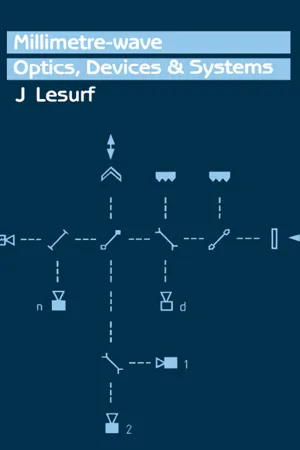![]()
Chapter 1
Signal Transmission, Modes and Gaussian Beams
1.1 Waveguides and General Mode Properties
Conventional electronic instruments use wires to send signals from place to place. As the signal frequency rises, it becomes increasingly difficult to make wired systems which work well. This is because—as was mentioned in the Preface—the actual signal is transmitted as an electromagnetic field which moves along just outside the wire. Some of this field can, therefore, be radiated away or coupled onto any other nearby wires.
Changes in the potential of a wire can be detected as a varying force on nearby charges. Similarly, changes in current alter the surrounding magnetic field and may induce currents on other wires. These effects are normally dealt with in electronics as ‘stray’ capacitances and inductances. They mean that some of the power that we wish to transmit via a wire may fail to arrive at its intended destination because it has been diverted elsewhere. It may also mean that some of the variations in potential and current arriving at the signal destination are the result of unwanted signals coupled onto the wire.
In many cases the signal wavelengths are far larger than the lengths of the transmitting wires and we can think of variations in current and charge as being uniform along the wire. If the frequency is increased sufficiently (or the wire extended), this assumption ceases to be reliable. Then the potential and current may be seen to vary along the length of the wire, i.e. there is a noticeable electric and magnetic field variation along the wire. Both of these fields vary periodically in time at the signal frequency. Now the wire will act as an antenna, radiating some signal power into the surrounding space.
As a result of these effects the efficiency of signal coupling along a wire tends to fall as the frequency rises. Various measures can be adopted to try to counteract these problems. One of the most useful is to replace the wires with a metallic waveguide. Although mainly used at microwave frequencies the metal waveguide is worth discussing in some detail here as it is used in many millimetre-wave systems and components. Many of the properties of waves propagating in waveguides of this type also turn out to be applicable in general to other forms of waveguide and to beams in space.
If we regard a normal wire as a length of metal surrounded by space, we can think of a metal waveguide as a length of space surrounded by metal. As with the wire, signal power is transmitted as an electromagnetic wave which moves along in the space outside the metal, i.e. the wave moves down the hole in the centre of the guide.
The most common form of waveguide is rectangular in cross section. Consider figure 1.1 which represents a rectangular guide.
Figure 1.1 Short piece of rectangular waveguide.
In order to determine the field pattern inside the waveguide, we have to find the appropriate solution for Maxwell’s equations. We need to know at least some of the field components at some point within the guide. How can we do this for a rectangular metal waveguide?
A rectangular waveguide can be regarded simply as a set of four mirrors placed so as to form a long metal box with open ends. With this in mind we can understand its behaviour by considering what happens when an electromagnetic wave is incident upon a metal surface.
An incident wave sets up a current in a thin layer at the surface. If the wave is plane parallel moving perpendicular to the surface, then the current distribution is uniform over the surface. Hence there will be no net accumulation of charge at any point on the surface. No potential differences are produced and the total electric field along the surface must remain zero everywhere.
The velocity of light inside a metal is generally far lower than in free space, i.e. the refractive index is very high. Hence very little of the incident wave penetrates into the metal. In order for the incident energy not to vanish mysteriously it must be reflected. As the total electric field along the surface must be zero, it follows that the incident and reflected waves have electric field components parallel to the surface which are equal and opposite.
A wave incident upon a metal surface at an angle can be regarded as a combination of two waves arriving simultaneously—one perpendicular to the surface, and the other parallel to the surface. The effect of the perpendicular wave is as described. The behaviour of the wave moving parallel to the surface depends upon the orientation of its electric field with r...

